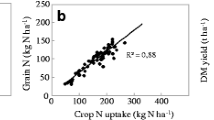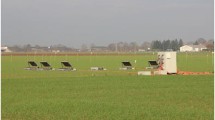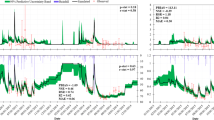Abstract
Land application of manures and slurries are a major source of pollution such as water contamination by nitrates and greenhouse gas emissions. NH3 and N2O emissions can be lowered by suitable spreading techniques. However, a comprehensive review of the impact of slurry spreading techniques is lacking. For that we developed a model, named OSEEP, that simulates the effect of slurry incorporation, slurry spatial distribution, and soil compaction on NH3 and N2O emissions. OSEEP integrates a soil compaction model, a hydraulic pedotransfer function, a NH3 volatilization model, and a crop model. We ran OSEEP for five sites in France for 7 years. Four techniques were simulated: broadcast spreading, band spreading, incorporation after surface spreading, and injection. We tested various sizes of slurry tankers and tractors. We calculated NH3 and N2O relative emissions from various spreading techniques with respect to band spreading. Results show good agreement between model calculation and published field data. We found that slurry applied by a self-propelled 15-m3 tanker with extra large tires led to an increase of 20 % in N2O emission, by comparison with a 15-m3 tanker trailed by a tractor. Hence, we show that soil compaction should be taken into account to optimize trade-offs between NH3 and N2O emissions.




Similar content being viewed by others
References
Bessou C, Mary B, Léonard J, Roussel M, Gréhan E, Gabrielle B (2010) Modelling soil compaction impacts on nitrous oxide emissions in arable fields. Eur J Soil Sci 61:348–363. doi:10.1111/j.1365-2389.2010.01243.x
Boote KJ, Jones JW, Pickering NB (1996) Potential uses and limitations of crop models. Agron J 88:704. doi:10.2134/agronj1996.00021962008800050005x
Brisson N, Launay M, Mary B, Beaudoin N (2008) Conceptual basis, formalisations and paramaterization of the STICS crop model. Quae, Versailles
Cannavo P, Recous S, Parnaudeau V, Reau R (2008) Modeling N dynamics to assess environmental impacts of cropped soils. Adv Agron 97:131–174. doi:10.1016/S0065-2113(07)00004-1
Clemens J, Vandré R, Kaupenjohann M, Goldbach H (1997) Ammonia and nitrous oxide emissions after landspreading of slurry as influenced by application technique and dry matter-reduction. II. Short term nitrous oxide emissions. J Plant Nutr Soil Sci 160:491–496
Défossez P, Richard G, Boizard H, O’Sullivan MF (2003) Modeling change in soil compaction due to agricultural traffic as function of soil water content. Geoderma 116:89–105. doi:10.1016/S0016-7061(03)00096-X
Dosch P, Gutser R (1996) Reducing N losses (NH3, N2O, N2) and immobilization from slurry through optimized application techniques. Fertil Res 43:165–171. doi:10.1007/BF00747697
EMEP-EAA (2009) Air pollutant emission inventory guidebook. European Environment Agency (EEA), Copenhagen
Gabrielle B, Laville P, Hénault C, Nicoullaud B, Germon JC (2006) Simulation of nitrous oxide emissions from wheat-cropped soils using CERES. Nutr Cycl Agroecosyst 74:133–146. doi:10.1007/s10705-005-5771-5
Galloway JN, Cowling EB (2002) Reactive nitrogen and the world: 200 years of change. Ambio 31:64–71. doi:10.1579/0044-7447-31.2.59
Garcia L, Genermont S, Bedos C, Bedos C, Simon NN, Garnier P, Loubet B, Cellier P (2012) Accounting for surface cattle slurry in ammonia volatilization models: the case of Volt’Air. Soil Sci Soc Am J 76:2184–2194. doi:10.2136/sssaj2012.0067
Génermont S, Cellier P (1997) A mechanistic model for estimating ammonia volatilization from slurry applied to bare soil. Agric For Meteorol 88:145–167. doi:10.1016/S0168-1923(97)00044-0
Hansen MN, Sommer SG, Madsen NP (2003) Reduction of ammonia emission by shallow slurry injection: injection efficiency and additional energy demand. J Environ Qual 32:1099–1104
Hénault C, Germon JC (2000) NEMIS, a predictive model of denitrification on the field scale. Eur J Soil Sci 51:257–270. doi:10.1046/j.1365-2389.2000.00314.x
IPCC (2006) 2006 IPCC Guidelines for National Greenhouse Gas Inventories, prepared by the National Greenhouse Gas Inventories Programme. IGES, Japan
Langevin B (2010) Prise en compte de la variabilité des émissions au champ dans l’Analyse de Cycle de Vie des systèmes agricoles. Application à l’épandage de lisier. Thèse de doctorat, Arts et Métiers ParisTech
Langevin B, Basset-Mens C, Lardon L (2010) Inclusion of the variability of diffuse pollutions in LCA for agriculture: the case of slurry application techniques. J Clean Prod 18:747–755. doi:10.1016/j.jclepro.2009.12.015
Mosier A, Syers JK, Freney JR (2004) Nitrogen fertilizer: an essential component of increased food, feed, and fiber production. In: Mosier A, Syers JK, Freney JR (eds) Agriculture and the nitrogen cycle. Island Press, Washington, pp 3–15
O’Sullivan MF, Henshall JK, Dickson JW (1999) A simplified method for estimating soil compaction. Soil Tillage Res 49:325–335. doi:10.1016/S0167-1987(98)00187-1
Payraudeau S, van der Werf HMG, Vertès F (2007) Analysis of the uncertainty associated with the estimation of nitrogen losses from farming systems. Agric Syst 94:416–430. doi:10.1016/j.agsy.2006.11.014
Peoples MB, Boyer EW, Goulding KWT et al (2004) Pathways of nitrogen loss and their impacts on human health and the environment. In: Mosier A, Syers JK, Freney JR (eds) Agriculture and the nitrogen cycle. Island Press, Washington, pp 53–69
Perrin A (2013) Evaluation environnementale des systèmes agricoles urbains en Afrique de l’Ouest: Implications de la diversité des pratiques et de la variabilité des émissions d’azote dans l’Analyse du Cycle de Vie de la tomate au Bénin. Thèse de doctorat, AgroParisTech
Rodhe L, Pell M, Yamulki S (2006) Nitrous oxide, methane and ammonia emissions following slurry spreading on grassland. Soil Use Manag 22:229–237. doi:10.1111/j.1475-2743.2006.00043.x
Saffih-Hdadi K, Défossez P, Richard G, Cui YJ, Tang AM, Chaplain V (2009) A method for predicting soil susceptibility to the compaction of surface layers as a function of water content and bulk density. Soil Tillage Res 105:96–103. doi:10.1016/j.still.2009.05.012
Sinclair TR, Seligman N (2000) Criteria for publishing papers on crop modeling. Field Crop Res 68:165–172. doi:10.1016/S0378-4290(00)00105-2
Smith KA, Jackson DR, Misselbrook TH, Pain BF, Johnson RA (2000) Reduction of ammonia emission by slurry application techniques. J Agric Eng Res 77:277–287. doi:10.1006/jaer.2000.0604
Smith E, Gordon R, Bourque C, Campbell A, Génermont S, Rochette P, Mkhabela M (2009) Simulating ammonia loss from surface-applied manure. Can J Soil Sci 89:357–367. doi:10.4141/CJSS08047
Soane BD, Ball BC, Arvidsson J, Basch G, Moreno F, Roger-Estrade J (2012) No-till in northern, western and south-western Europe: a review of problems and opportunities for crop production and the environment. Soil Tillage Res 118:66–87. doi:10.1016/j.still.2011.10.015
Søgaard HT, Sommer SG, Hutchings NJ, Huijmans JFM, Bussink DW, Nicholson F (2002) Ammonia volatilization from field-applied animal slurry—the ALFAM model. Atmos Environ 36:3309–3319. doi:10.1016/S1352-2310(02)00300-X
Sommer SG, Hutchings NJ (2001) Ammonia emission from field applied manure and its reduction—invited paper. Eur J Agron 15:1–15. doi:10.1016/S1161-0301(01)00112-5
Thirion F, Chabot F (2003) Épandage des boues résiduaires et effluents organiques. Cemagref editions, Antony
Thirion F, Pradel M (2010) L’enjeu environnemental des performances mécaniques des épandeurs. Sci Eaux Territ 48–53
Thompson RB, Pain BF, Rees YJ (1990) Ammonia volatilization from cattle slurry following surface application to grassland—II. Influence of application rate, wind speed and applying slurry in narrow bands. Plant Soil 125:119–128. doi:10.1007/BF00010751
Thorman E, Hansen N, Misselbrook TH, Sommer G (2008) Algorithm for estimating the crop height effect on ammonia emission from slurry applied to cereal fields and grassland. Agron Sustain Dev 28:373–378. doi:10.1051/agro:2008013
Van Genuchten MT (1980) Closed-form equation for predicting the hydraulic conductivity of unsaturated soils. Soil Sci Soc Am J 44:892–898. doi:10.2136/sssaj1980.03615995004400050002x
Vandré R, Clemens J, Goldbach H, Kaupenjohann M (1997) NH3 and N2O emissions after landspreading of slurry as influenced by application technique and dry matter-reduction. I. NH3 emissions. J Plant Nutr Soil Sci 160:303–307
Velthof GL, Kuikman PJ, Oenema O (2003) Nitrous oxide emission from animal manures applied to soil under controlled conditions. Biol Fertil Soils 37:221–230
Webb J, Pain B, Bittman S, Morgan J (2010) The impacts of manure application methods on emissions of ammonia, nitrous oxide and on crop response—a review. Agric Ecosyst Environ 137:39–46. doi:10.1016/j.agee.2010.01.001
Weslien P, Klemedtsson L, Svensson L, Galle B, Kasimir-Klemedtsson Å, Gustafsson A (1998) Nitrogen losses following application of pig slurry to arable land. Soil Use Manag 14:200–208. doi:10.1111/j.1475-2743.1998.tb00150.x
White JW, Hoogenboom G, Kimball BA, Wall GW (2011) Methodologies for simulating impacts of climate change on crop production. Field Crop Res 124:357–368. doi:10.1016/j.fcr.2011.07.001
Wösten JHM, Lilly A, Nemes A, Le Bas C (1999) Development and use of a database of hydraulic properties of European soils. Geoderma 90:169–185. doi:10.1016/S0016-7061(98)00132-3
Wulf S, Maeting M, Clemens J (2002a) Application technique and slurry co-fermentation effects on ammonia, nitrous oxide, and methane emissions after spreading: II. greenhouse gas emissions. J Environ Qual 31:1795–1801. doi:10.2134/jeq2002.1795
Wulf S, Maeting M, Clemens J (2002b) Application technique and slurry co-fermentation effects on ammonia, nitrous oxide, and methane emissions after spreading: I. Ammonia volatilization. J Environ Qual 31:1789–1794. doi:10.2134/jeq2002.1795
Acknowledgments
We are very grateful to L. Garcia for his help with Volt’Air simulations. We also thank V. Parnaudeau, B. Mary, N. Beaudoin, M. Launay, and the late N. Brisson for their advices with STICS, as well as S. Guillaume, O. Naud, C. Tinet, and B. Gabrielle for their expertise on modeling and programming issues, and P. Roux for his support and advice. This work was part of the research project “ECODEFI” (ecodesign of spreading equipment) and was financially supported by ADEME.
Author information
Authors and Affiliations
Corresponding author
About this article
Cite this article
Langevin, B., Génermont, S., Basset-Mens, C. et al. Simulation of field NH3 and N2O emissions from slurry spreading. Agron. Sustain. Dev. 35, 347–358 (2015). https://doi.org/10.1007/s13593-014-0248-z
Accepted:
Published:
Issue Date:
DOI: https://doi.org/10.1007/s13593-014-0248-z




